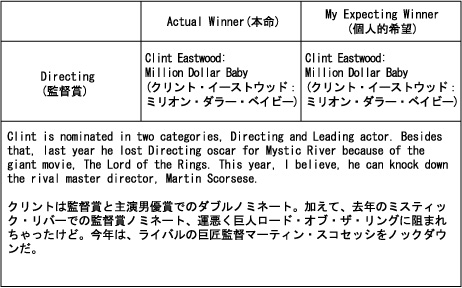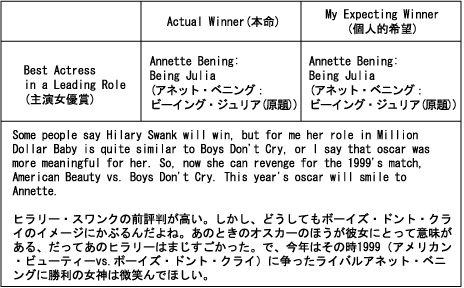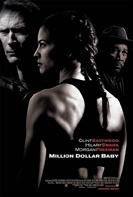
Director: Alejandro Amenabar
Casts: Javier Bardem, Belen Rueda, Lola Duenas
Release Date in Japan: April 16, 2005
Story: "The Sea Inside" is the real life story of Spaniard Ramon Sampedro (played by Bardem), who fought a 30-year campaign in favor of his right to die with dignity. Two women try to change his life - Julia (Belen Rueda) is a lawyer who supports his cause, and Rosa (Lola Duenas) is a neighbor who wants to convince him that life is worth living. The two women's encounters with the charismatic Ramon lead to change in their own lives.
It made me think about death with dignity.
When I was watching this movie, especially near the last scene, I had a little wired feeling to myself. The scene was about Ramon’s final decision of his life, and I thought I deeply concentrate on the story and should be touched the last scene. But actually what I was attracted to at that time was the other audiences’ noises… some people sounds like, they are sobbing, and the others are blowing their nose with their handkerchief… Then, I just realized why my feeling at this moment was different from those people’s… I couldn’t cry for the decision Ramon finally made. I don’t want to bring the whole story here, so I cannot say it in detail, but this fact let me know that at least I am not against the idea of death with dignity.
The main character in this movie, Ramon(Javier Bardem), was always lying down on a bed, and couldn’t do anything except writing a poem because of his past accident. However, he had one freedom that he can travel anywhere he wants to go in his mind. His imagination let him fly away from the window next to his bed.
For me, even he lost his physical freedom, but he still had mental freedom. This is important; this fact does not change no matter whether he is alive or dead. This movie taught me that death might take away physical freedom from us, but it cannot take away mental freedom together. Even after we die, our mind is still alive somewhere, especially in people’s mind.
There are many people in this world who are obliged to be alive on a bed and are willing to die. This movie gave me some idea about how those people thinks. They may feel isolated or lonely just because they are different from the other people in terms of their physical condition. So, they hope to free themselves from the physical restriction in order to pursue entire freedom and be fair with other people.
In the movie, he sometimes repeated, “life is a right, not a obligation.” This means he wanted to have the same right as the other people to achieve a life with real freedom. Dignity in the idea of death with dignity indicates not only dignity for the will of those who wants to die, but also for the right that everybody is in fair to freedom. It is difficult to judge how much peoples’ freedom is respected and restricted, but as long as the freedom hurts nobody, I think the freedom has to be given to anybody as much as possible.
In end of this movie, Ramon was given the freedom that he has been pursuing for 26 years. Finally he was dignified with real freedom. In this sense, I understand why I couldn’t cry for the ending because he could be happy at the last moment of his life.
ストーリー:この「海を飛ぶ夢(原題:The Sea Inside)」は、30年間あまり尊厳死について闘いぬいたラモン・サンペドロ(ハビエル・バルデム)という実在した一人の男の物語である。彼の事例を扱う弁護士のフリア(ベレン・ルエダ)と彼に活きる意味を訴えかけるローザ(ローラ・ドゥエニャス)という二人の女性は彼の人生を変えようと必死だった。ラモンは彼女たちとの出会い、彼女たちもラモンに出会うことで、彼ら三人の人生は大きく変化を遂げるのであった。
尊厳死について考えさせられた。
ラストシーンを見ていたときだった。自分でもなんだか変な自分に気がついた。主人公のラモンが自分の生に最後の決断を下すシーンだった。自分ではそれなりに話にのめりこんで、ラストシーンに涙でも流そうかと思っていたのだが、実際、まったく意図していなかった他の観客の雑音を気にする自分がいた。ある人はすすり泣きのような音、ある人はハンカチで鼻をかむような音。で、「あれ、なんで他の観客とリアクションが違うんだ!?」ってふと思ってしまった。
ラモンの下した最後の決断に、みんななんで泣くのかよく分からなかった。ここでネタばれするわけにはいかないので、詳しくは映画を観てもらいたいが、その奇妙な感覚は、尊厳死の問題に対して、反対しているわけではないという、自分の立場を再確認させてくれたような気がする。
この映画の主人公であるラモン(ハビエル・バルデム)は、事故に遭い寝たきりで、詩を書く以外のことは何もできない生活を送っていた。しかしそんな彼にもたった一つの自由が許されていた。それは彼は心の中で行きたい所ならどこへでも旅をすることができたのである。彼の創造力は、彼をベット際の窓から飛び立たせるに足るものだった。
彼は体の自由を失った、しかし決して精神の自由を失ったわけではない。これは重要なことで、この事実は彼が生きていても、死んでいても不変である。この映画を観て思った。死は私たちから体の自由を奪いはするが、精神の自由まで一緒に奪うことはできないということ。私たちが死んだ後も精神は、人の心とか、どこかで必ず活きるということ。
世の中にはたくさん、ベットの上の生きることを余儀なくされ、死を渇望する人たちがいる。この映画を観て、その人たちの気持ちに少しふれることができた気がする。たぶんに、自分の肉体的状態が他の人と異なるというために、彼・彼女たちは孤独感や寂寥感を感じている。それゆえに、その肉体的拘束から自身を解放し他の人たちと同様に真の自由を求めたいと思うのである。
映画中ラモンは、「人生は権利であり、義務ではない。」と繰り返した。彼は他の人同様に真の自由に満ちた生活を送る権利を得たかったのだろう。「尊厳死」という言葉の中の「尊厳」の意味するものとは、死を望む人の意思を尊厳するということだけではなく、全ての人に対し公平な自由を享受する権利を尊厳するということでもある。どこまで人の自由を尊重し、制限するかは難しい問題ではあるが、少なくともその自由が誰も傷つけない限りは、自由というものは全ての人に最大限与えられるべきだと思う。
映画の最後で、ラモンは26年間求め続けた自由を得ることができた。最後に彼は真の自由によって尊厳を保たれたのである。その意味において、自分が泣けなかった理由が分かった。だって人生の最後の最後で彼は本当に幸せになれたのだから。











